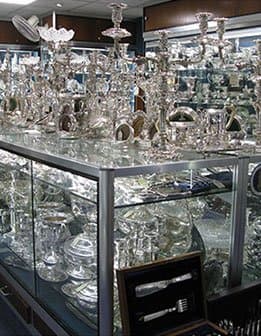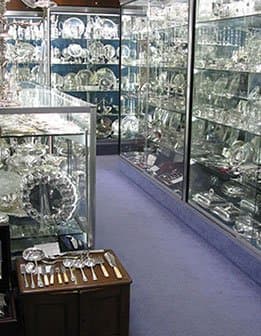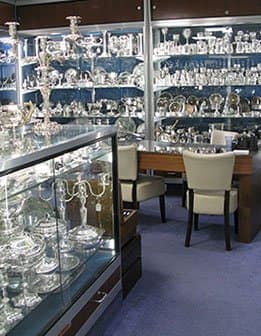Georgian silver is silverware produced and belonging to the Georgian era that ranged over a 120 year period between 1714 – 1837. Although William IV, with the death of George IV, ascended the throne in 1830 (and was obviously not a George) he is generally brought into the conversation. The Georgian Kings were: George I (1714-27); George II (1727-60); George III (1760 – 1820); George IV (1820-30) and William IV (1830-7). The period in question saw many developments across Britain and the rest of the world. With Britain through empire and industrialisation amassing great wealth, which was being expressed in all forms of art, with creations in silver an integral part of this.
( Tea Caddy made by Thomas Parr of London in 1715 )
At the beginning of the George I period, silver tended to be of a restrained form without much ornament – as illustrated by this tea caddy of 1715 made by Thomas Parr of London. However, the French Huguenot refugee silversmiths – who entered London in the late 17th and early 18th century – were already creating a shift in silversmithing techniques and their style of decoration. This really started to manifest itself by the early 1730s when the most important silversmiths of the day, such as Paul de Lamerie, Peter Archambo, Paul Crespin and several others were introducing a restrained Rococo ornamentation to their productions.
(Kettle & Stand, Peter Archambo of London 1739-40)
By the early 1740’s to mid-1750’s full blown Rococo
(Rococo Cake Basket made by Samuel Herbert of London in 1751)
and emphasis on cast and applied work, hand chasing and bold decorative motifs.
It always must be kept in mind that plain styles, notably in items such as sauce boats, tankards and mugs, kept their place amidst the new Rococo creations. Indeed, it would be remiss not to mention that a tankard or mug of the 18th century with any form of Rococo ornament, with a few exceptions (and I mean a few), has normally been tampered with by a silversmith of the 19th century whose clients demanded mugs and tankards with floral decoration, hunting scenes and suchlike.
By the later 1750’s and early 1760’s, a sudden confluence of differing styles started to compete for attention. Chinese influence in art was making quite an impact (think Kew Gardens pagoda built 1761-2) and the other new boy on the scene as it were was the rise of neoclassicism, which leant heavily on designs from Greece and Rome which were made fashionable by the Grand Tour.
(Wine Coasters in “Chinese Chippendale Style” with the crest of the Archbishop of Canterbury made by Samuel Herbert of London in 1765)
(Set of Four neoclassical Candlesticks made for the Earl of Hillsborough in 1767)
Hillsborough Castle has been a grand family home , modelled in the neoclassical form which is now the official home of the Secretary of State for Northern Ireland, and a royal residence. Members of the Royal Family stay at Hillsborough when visiting Northern Ireland.
Within these new styles the older Rococo styles still carried weight right up until the 1770’s and the styles were sometimes mixed.
(Epergne, 1768 London made by Butty and Dumee, which exhibits elements of Chinese style within the Rococo elements)
By the later 1770s and early 1780s, the use of engraving with steel tools – often referred to as “Bright Cut” – became popular and it was a way of decorating a plain surface in a much more delicate and lighter style than in previous periods.
(Salver with bright cut engraving , made by John Hutson of London in 1786 with the crest of Hobson)
The engraving of silver in the 1780’s and 1790’s has never been bettered, and there is no one today that I have seen who can match the sort of quality hand engraving that was produced in the latter part of the 18th century. The 1790’s and very early 1800’s were characterized by very simple forms, often with minimal decoration and sometimes with subtle fluting.
(Pair of Candelabra made in 1796 by John Green of Sheffield)
(Set of Four Candlesticks made in 1802 by Nathaniel Smith of Sheffield)
By the time of the Battle of Trafalgar (1805) a boldness and robustness was replacing the lighter more delicate styles, with Royal Goldsmiths, such as Paul Storr and John Bridge, setting the benchmark. A style that was introduced (although quite rare) was the taste for all things Egyptian. This was very fashionable amongst the upper echelons of society in the early 1800′ ws after Nelson’s victory at the battle of the Nile in 1798.
(Centrepiece made in the Egyptian taste by Royal Goldsmith, John Bridge in 1824)
By the later George III period and into the George IV period in the 1820’s, the Rococo taste came roaring back with some extremely decorative and exotic pieces being made.
( A late Rococo Tea & Coffee service made in 1820 by Craddock & Reid of London)
As we move into the 1830s and later, styles are quite complex as they are often quite blended in form and not so obviously distinct in character.
In summary, whilst there are quite distinct periods stylistically, there is often a lot of overlap and fluidity within this. Clients often say to me “I want it Georgian because it’s plain” or “I don’t like Victorian because it’s ornate” – the actual reality is that the plainest silver is produced in the Georgian period, and some of the most decorative. For example, just look at the four candlesticks from 1802 compared to the tea and coffee service of 1820 – only 18 years apart but stylistically so different.
Author: John Walter
Our Makers
An A to Z list of silversmiths featured on our website
About Us
If you see something in Archive that you would have liked please contact us as we might be able to source
Our Store
Our store is situated in vaults 3 and 5 on the right-hand side of the main corridor at The London Silver Vaults















